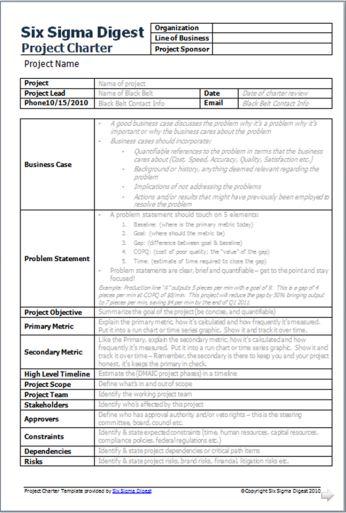How to Write a Project Charter
 In a previous article we stated that DMAIC is a structured and rigorous methodology designed to be repeatedly applied to ANY process in order to achieve Six Sigma. We also stated that DMAIC was a methodology that refers to 5 phases of a project.
In a previous article we stated that DMAIC is a structured and rigorous methodology designed to be repeatedly applied to ANY process in order to achieve Six Sigma. We also stated that DMAIC was a methodology that refers to 5 phases of a project.
- Define
- Measure
- Analyze
- Improve
- Control
Given that the premise of the DMAIC methodology is project based, we must take the necessary steps to define and initiate a project; hence the need for a project charter.
The purpose of a project charter is to provide vital information about a project in a quick and easy to comprehend manner. Project charters are used to get approval and “buy-in” for projects and initiatives. They are also useful in declaring specific characteristics of a project:
- Business Case
- Problem
- Project Objective
- Project Scope
- Project Team
- Decision authorities
- Project Leader
- Success Measures
Project Charter: Key Elements
Title
Projects should have a name, title or some reference that identifies the project. Branding can be an important ingredient in the success of a project so be sure your project has a reference name or title.
Leader
All projects need a declared leader or someone who is responsible for its execution and success. You may hear references to RACI throughout in your Six Sigma journey. RACI stands for Responsible, Accountable, Consulted, Informed and identifies what people play those roles in a project. Every project must have declared leaders indicating who’s responsible and who’s accountable.
Business Case
A Business Case is the quantifiable reason why the project is important. Business Cases help shed light on problems. They explain why a business should care. Business Cases must be quantified and stated succinctly. COPQ is a key method of quantification for any business case.
Problem Statement & Objective
A properly written problem statement has an objective statement woven into it. There should be no question as to the current state or the goal of the project. A gap should be declared (the gap is the difference between the present state and the goal state). The project objective should be to close all or part of the gap. Valuation or COPQ is the monetary value assigned to the gap. Lastly, included in a well written problem statement is a reference to an expected timeline for project completion.
· Problem Statement Examples
- Process defect rates are currently 17% with a goal of 2%. This represents an unwarranted defect rate 15% with a COPQ of $7.4 million dollars. The goal of this project is to reduce this gap by 50% before Nov 2010 putting process defect rates at 9.5% and saving $3.7MM.
- Process cycle time has averaged 64 minutes since Q1 2009. However, production requirements put the cycle time goals at 48 min. This 16 min gap is estimated to cost the business $296,000. The goal of this project is close reduce cycle time 16 min. by the end of the 4th quarter 2010 and capture all $296,000 cost savings.
Primary & Secondary Metrics
All project must have a measure of success. There is no reason for a project with an expected outcome. Most preferably a measurable one. Primary and secondary metrics are mandatory for any Six Sigma project. Metrics give clarity to the purpose of the work, they establish the baseline or starting point and how the initiative will be judged as it progresses.
Other Elements of a Good Project Charters
- Scope Statement – defined by high level process map
- Stakeholders Identified – who’s affected by the project
- Approval Authorities Identified – who makes the final call
- Review Committees Defined – who’s on the review team
- Risks & Dependencies Highlighted – identify risks & critical path items
- Project Team Declared – declare team members
- Project Timeline Estimated – set high level timeline expectations

